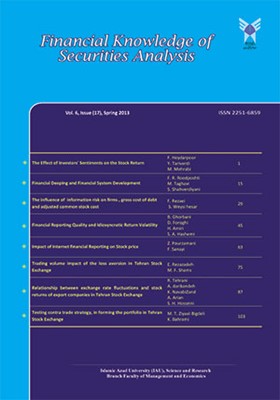ارزیابی تاثیر سطوح مختلف افشای ریسک شرکت بر ادراکِ سرمایهگذاران: تحلیلِ اقلیدسی براساس متن کاوی
الموضوعات :
دانش مالی تحلیل اوراق بهادار
محمدحسین لبیب زاده
1
,
رضوان Rezvan
2
,
اله کرم صالحی
3
,
فرشین هرمزی
4
1 - دانشجوی دکتری، گروه حسابداری، واحد اهواز، دانشگاه آزاد اسلامی، اهواز، ایران
2 - استاد تمام مدعو، گروه حسابداری، واحد اهواز، دانشگاه آزاد اسلامی، اهواز، ایران/گروه حسابداری، دانشگاه خاتم، تهران، ایران. (نویسنده مسئول)
3 - استادیار، گروه حسابداری ، واحد مسجدسلیمان، دانشگاه آزاد اسلامی، مسجد سلیمان، ایران
4 - استادیار، گروه آمار، واحد اهواز، دانشگاه آزاد اسلامی، اهواز، ایران
تاريخ الإرسال : 25 الثلاثاء , ربيع الثاني, 1443
تاريخ التأكيد : 24 الخميس , ذو القعدة, 1443
تاريخ الإصدار : 25 الثلاثاء , محرم, 1444
الکلمات المفتاحية:
سطوح گزارشگری ریسک,
درک سرمایهگذاران,
ساختارِ تحلیل محتوایی,
ملخص المقالة :
افشای ریسکهای اصلی واحد تجاری و تغییرات در آن ریسکها به همراه برنامهها و راهبردهای مدیریت، برای مقابله یا کاهش این ریسکها و میزان اثربخشی راهبردهای مدیریت ریسک است. این افشای اطلاعات، به استفادهکنندگان کمک میکند تا ریسکهای واحد تجاری و همچنین پیامدهای مورد انتظار آنها را ارزیابی نمایند. هدف این پژوهش، ارزیابی تاثیر سطوح مختلف افشای ریسک شرکت بر ادراک ریسک سرمایهگذاران بود. در این پژوهش باتوجه به اینکه مبنای مشخص و منسجمی در خصوص، تفکیکِ سطوحِ گزارشگری ریسک وجود نداشت به پشتوانهی روش شناسی بخش کیفی تلاش گردید تا براساس، فرآیندِ ساختارِ تحلیل محتوایی نسبت به شناساییِ ابعادِ افشای ریسک اقدام شود. در این پژوهش به منظور آزمون فرضیههای تدوین شده از پرسشنامه مبتنی بر سناریو استفاده شده است. قلمرو زمانی پژوهش سال ۱۳۹۹، جامعه آماری شامل سرمایهگذاران فعال در بورس اوراق بهادار تهران بودند که تعداد ۱۶۰ نفر به عنوان حجم نمونه انتخاب و مورد بررسی قرار گرفتند. نتایجِ پژوهش در بخش کیفی از وجود دو مقوله اصلی به عنوانِ سطوحِ تفکیکِ گزارشگری ریسکِ شرکتهای بازار سرمایه حکایت دارد. همچنین نتایج در بخش کمی نشان داد، میانگینِ ادراک سرمایهگذاران در همگرایی افشاء ریسک نسبت به واگرایی در افشاء ریسک بیشتر است.
المصادر:
خوشخلق، ایرج.، طالبنیا، قدرتاله. (1400). تبیین اثر مفاهیم گزارشگری مالی بر سطح افشای ریسک در گزارشگری مالی سالانه در شرکتهای پذیرفته شده در بورس اوراق بهادار تهران، دانش سرمایهگذاری، 10(38): 455-473.
خیامبور، اکبر.، خردیار، سینا.، رضایی، فرزین.، وطنپرست، محمدرضا. (1399). ارزیابی سودمندی درتصمیم افشاء اطلاعات مولفههای ریسک، مهندسی مالی و مدیریت اوراق بهادار، 11(42): 419-445.
ساجدی، هدیه.، ساداتتقوی، زهرا.، تقوی، فرناز سادات. (۱۳۹۴). مقدمهای بر بازیابی اطلاعات، نشر: نیاز دانش (چاپ اول).
سرلک، ولی.، خلجی، مجید.، گردان، محمد. (۱۳۹۵). بررسی سیستمهای هوشمند پرسش و پاسخ خودکار زبان فارسی با استفاده از اطلاعات وب جهانی دانشنامه رشد و ویکیپدیا. مقاله کنفرانس. دومین کنفرانس بینالمللی یافتههای نوین پژوهشی در علوم، مهندسی و فناوری.
میریقهدریجانی، نازنین.، اربابیان، علیاکبر. (1397). تاثیر ساز و کارهای حاکمیت شرکتی بر گزارشگری ریسک، پژوهشهای حسابداری مالی و حسابرسی، 10(40): 111-136.
Abraham, S., Shrives, P.J. (2014). Improving the relevance of risk factor disclosure in corporate annual reports. The British Accounting Review, 46(1): 91-107.
Campbell, J.L., Chen, H., Dhaliwal, D.S., Lu, H., Steele, L.B. (2014). The information content of mandatory risk factor disclosures in corporate filings. Review of Accounting Studies, 19(1): 396-455
Dobler, M. (2008). Incentives for risk reporting: A discretionary disclosure and cheap talk approach. International Journal of Accounting, 43(2), 184-206.
Dobler, M., Lajili, K., Zéghal, D. (2011). Attributes of corporate risk disclosure: and international investigation in the manufacturing sector. Journal of International Accounting Research, 10(2): 1-22.
El-Diftar, D. and Elkalla, T. (2019). The value relevance of accounting information in the MENA region: A comparison of GCC and non-GCC country firms, Journal of Financial Reporting and Accounting, 17(3): 519-536. https://doi.org/10.1108/JFRA-09-2018-0079
Elshandidy, T., Elmassri, M. and Elsayed, M. (2021). Integrated reporting, textual risk disclosure and market value, Corporate Governance, https://doi.org/10.1108/CG-01-2021-0002
Gul, F.A., Leung, S. (2004). Board leadership, outside directors’ expertise and voluntary corporate disclosure. Journal of Accounting and Public Policy, 23(1): 351–379.
Guthrie, J., Manes Rossi, F., Orelli, R.L. and Nicolò, G. (2020). Investigating risk disclosures in Italian integrated reports, Meditari Accountancy Research, 28(6): 1149-1178. https://doi.org/10.1108/MEDAR-10-2019-0596
Hirshleifer, J. (1973). Papers and Proceedings of the Eighty-fifth Annual Meeting of the American Economic Association || Where Are We in the Theory of Information? . American Economic Review, vol. 63, issue 2, 31-39.
Khandelwal, C., Kumar, S. and Verma, D. (2021). Exploring financial risks disclosure: evidence from Indian listed companies, Qualitative Research in Financial Markets, https://doi.org/10.1108/QRFM-11-2019-0140
Kravet, T., Muslu, V. (2013). Textual risk disclosures and investors’ risk perceptions, Review of Accounting Studies volume 18(2): 1088–1122. https://doi.org/10.1007/s11142-013-9228-9
Li, J., He, M, X. (2018). Risk Disclosure in Annual Reports and Corporate Investment Efficiency, International Review of Economics and Finance, https://doi.org/10.1016/j.iref.2018.08.021
Linsley, P.M., Shrives, P.J. (2006). Risk reporting: A study of risk disclosures in the annual reports of UK companies. British Accounting Review, 38(4): 387-404.
Losada-Otálora, M. and Alkire (née Nasr), L. (2019). Investigating the transformative impact of bank transparency on consumers’ financial well-being, International Journal of Bank Marketing, 37(4): 1062-1079. https://doi.org/10.1108/IJBM-03-2018-0079
Miihkinen, A. (2013). The usefulness of firm risk disclosures under different firm riskiness, investor-interest, and market conditions: New evidence from Finland. Advances in Accounting, incorporating Advances in International Accounting, 29(2): 312–331.
Miihkinen, A. (2013). The usefulness of firm risk disclosures under different firm riskiness, investor-interest, and market conditions: New evidence from Finland. Advances in Accounting, incorporating Advances in International Accounting, 29(1): 312–331.
Mohobbot, A. (2005). Corporate risk reporting practices in annual reports of Japanese companies. Japanese Journal of Accounting, 16(1): 113-133.
Rajab, B., Handley-Schachler, M. (2009). Corporate risk disclosure by UK firms: trends and determinants. World Review of Entrepreneurship, Management and Sustainable Development, 5(3), 224-243.
Rose, J, M., Norman, C, S., Rose, A, M. (2010). Perceptions of Investment Risk Associated with Material Control Weakness Pervasiveness and Disclosure Detail, The Accounting Review, 85(5): 1787-1807.
Salton, G., A. Wong, and C. S. Yang. (1975). A vector space model for automatic indexing. Communications of the ACM 18(2): 613–620.
Samkin, G., Schneider, A. (2010). Accountability, narrative reporting and legitimation: the case of a New Zealand public benefit entity. Accounting, Auditing & Accountability Journal, 23(2): 256-289.
_||_


